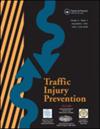Bridging the gap: Mechanistic-based cyclist injury risk curves using two decades of crash data
IF 1.6
3区 工程技术
Q3 PUBLIC, ENVIRONMENTAL & OCCUPATIONAL HEALTH
引用次数: 0
Abstract
Objective
Injury risk curves are vital in quantifying the relative safety consequences of real-world collisions. Previous injury risk curves for bicycle-passenger vehicle crashes have predominantly focused on frontal impacts. This creates a gap in cyclist injury risk assessment for other geometric crash configurations. The goal of this study was to create an “omnidirectional” injury risk model, informed by known injury causing mechanisms, that is applicable to most geometric configurations.
Methods
We used data from years 1999–2022 of the German In-Depth Accident Study (GIDAS). We describe the pattern of injuries for cyclists involved in collisions with passenger vehicles, and we developed injury risk functions at various AIS levels for these collisions. A mechanistic-based approach accounting for biomechanically-relevant variables was used to select model parameters a priori. Cyclist age (including children) and sex were regarded as relevant predictors of injury risk. Speed and impact geometry were captured through a novel predictor, Effective Collision Speed, which transforms the vehicle and cyclist speeds into a single value and incorporates frictional considerations observed during side engagements. Cyclist engagement with the vehicle was captured with a variable demonstrating the potential for a normal projection. We additionally present analyses weighted toward German nationwide data.
Results
We identified 6,576 cyclists involved in collisions with passenger vehicles. AIS3+ cyclist injuries occurred most often in the head, thorax, and lower extremities. Effective Collision Speed was a strong predictor of injury risk. Collisions with a potential for a normal projection were associated with increased risk, though this was only significant at the MAIS2+F severity level. Younger children had slightly higher injury risk compared to young adults, while elderly cyclists had the highest risk of AIS3+ injury. Sex was a significant predictor only for the MAIS2+F injury risk curves.
Significance
U.S. cyclist fatalities increased 55% from 2010 to 2021. To reduce injuries and fatalities, it is crucial to understand cyclist injury risk. This study builds on previous analyses by including children, incorporating additional mechanistic predictors, broadening the scope of included crashes, and using weighting to generalize these estimates toward national German statistics.
缩小差距:利用二十年的撞车数据绘制基于机理的骑车人受伤风险曲线。
目的:伤害风险曲线对于量化实际碰撞的相对安全后果至关重要。以往的自行车与乘用车碰撞伤害风险曲线主要集中于正面碰撞。这就造成了对其他几何碰撞配置的骑车人伤害风险评估的空白。本研究的目标是建立一个 "全方位 "伤害风险模型,该模型以已知的致伤机制为基础,适用于大多数几何配置:我们使用了德国深度事故研究(GIDAS)1999-2022 年的数据。我们描述了与乘用车发生碰撞的骑车者的受伤模式,并针对这些碰撞制定了不同 AIS 等级的受伤风险函数。我们采用基于机理的方法,考虑到生物力学相关变量,先验地选择模型参数。骑车人的年龄(包括儿童)和性别被视为受伤风险的相关预测因素。速度和撞击几何形状通过新的预测因子 "有效碰撞速度 "来捕捉,该预测因子将车辆和骑车人的速度转换为单一值,并将侧面碰撞时观察到的摩擦因素纳入其中。骑车人与车辆的接触是通过一个变量来捕捉的,该变量显示了正常预测的潜力。此外,我们还对德国全国的数据进行了加权分析:结果:我们确定了 6,576 名与乘用车发生碰撞的骑车人。AIS3+ 级的骑车者受伤部位多为头部、胸部和下肢。有效碰撞速度是预测受伤风险的重要指标。可能出现正常投影的碰撞与风险增加有关,但这只在 MAIS2+F 严重程度时才显著。与年轻成年人相比,年幼儿童的受伤风险略高,而老年骑车者的 AIS3+ 受伤风险最高。只有在 MAIS2+F 受伤风险曲线上,性别才是一个重要的预测因素:意义:从 2010 年到 2021 年,美国骑自行车者的死亡人数增加了 55%。为了减少伤亡事故,了解骑自行车者的受伤风险至关重要。本研究在之前分析的基础上,纳入了儿童、更多的机理预测因素、扩大了纳入的碰撞范围,并使用加权法将这些估计值归纳为德国全国的统计数据。
本文章由计算机程序翻译,如有差异,请以英文原文为准。
求助全文
约1分钟内获得全文
求助全文
来源期刊

Traffic Injury Prevention
PUBLIC, ENVIRONMENTAL & OCCUPATIONAL HEALTH-
CiteScore
3.60
自引率
10.00%
发文量
137
审稿时长
3 months
期刊介绍:
The purpose of Traffic Injury Prevention is to bridge the disciplines of medicine, engineering, public health and traffic safety in order to foster the science of traffic injury prevention. The archival journal focuses on research, interventions and evaluations within the areas of traffic safety, crash causation, injury prevention and treatment.
General topics within the journal''s scope are driver behavior, road infrastructure, emerging crash avoidance technologies, crash and injury epidemiology, alcohol and drugs, impact injury biomechanics, vehicle crashworthiness, occupant restraints, pedestrian safety, evaluation of interventions, economic consequences and emergency and clinical care with specific application to traffic injury prevention. The journal includes full length papers, review articles, case studies, brief technical notes and commentaries.
 求助内容:
求助内容: 应助结果提醒方式:
应助结果提醒方式:


